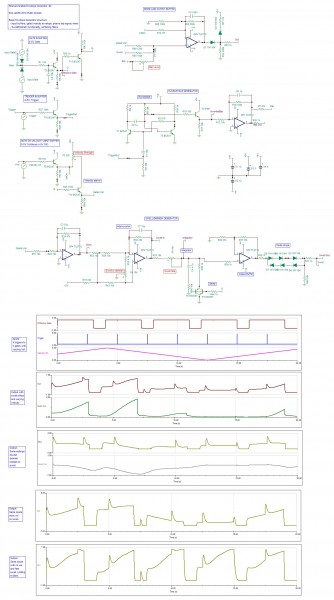Ricko
Joined: Dec 25, 2007
Posts: 251
Location: Sydney, Australia
Audio files: 27
|
 Posted: Mon Sep 17, 2018 7:19 am Post subject:
New plosive/variable envelope gen circuit (e.g. brass/wind) Posted: Mon Sep 17, 2018 7:19 am Post subject:
New plosive/variable envelope gen circuit (e.g. brass/wind) |
  |
|
So I have been trying to think of alternatives to conventional Envelope Generators. I think there are two basic conventional designs: the ADSR family of a sequencer through level and time controls, and the oscillator-with-no-reset family. I posted some plucked/damped designs yesterday, and here is another approach.
While I am clearing out my simulator files, here is another envelope generator circuit, this time simulating some aspects of brass/woodwind instruments that conventional ADSR cannot do. (You could get almost get the same effect on a modular with an AD and AR envelope generator, two or three multipliers, a slew generator, and a mixer.)
Again, because the circuit is dense, the first diagram here is gives the fundamental operation, to help explain clearly, I hope. (But the circuit in this diagram isn't intended to produce characteristic brassy/wind-ish envelopes, though it is OK as far as it goes. The subsequent post below has the full circuit better for that.)
The envelope is made by summing two components:
First, the blip or impulse corresponding to the initial extra pressure that a brass or wind player uses to give energy to the air column. This is mixable. It comes from a trigger input (often this would be derived from the gate signal.)
Second the value of a velocity input, gated by the gate input. There is a pot to vary this from a fixed value to 100% of the velocity input. The velocity input can be a continuous signal, it is not, say, sampled at gate-on time. It can be used both for good performance control by a human if you don't have access to a breath controller, but also to allow automated/semi-random articular with an LFO etc.
The trigger input is independent of the gate. So you can have secondary triggers while the gate is on (for extra notes, or Heart of Glass rhythm, or rachetting, or even flutter tonguing, in order of speed.)
To compare this with an ADSR: the blip corresponds to a short AD, the velocity level sets the S and the R is set very short. (However in some combinations, the swell circuit which is introduced in the next post can act like a long A or D.) The envelope is perhaps more like the Yamaha style envelopes that allow an initial level and a decay 2: however, we don't use that method. I previously used the gated velocity in my VST Neumixturtrautonium, and the idea works well I think.
The subsequent post will complete the diagram below: it is missing filter-related items that soften the envelope, plus the swell/diminish feature. The charts there will show numerous envelopes that are not possible with conventional ADSR envelope generators.
| Description: |
|
| Filesize: |
212.99 KB |
| Viewed: |
232 Time(s) |
| This image has been reduced to fit the page. Click on it to enlarge. |

|
Last edited by Ricko on Mon Sep 17, 2018 7:58 am; edited 4 times in total |
|
Ricko
Joined: Dec 25, 2007
Posts: 251
Location: Sydney, Australia
Audio files: 27
|
 Posted: Mon Sep 17, 2018 7:34 am Post subject:
Full circuit Posted: Mon Sep 17, 2018 7:34 am Post subject:
Full circuit |
  |
|
So here is the full circuit for the plosive/variable envelope generator. The minor difference from the previous circuit is tweaked values and some filter caps. The major difference is the swell/diminish chain.
Apart from the pots for blip mix and velocity strength, there are two pots for swell speed and for swell/diminish.
A feature of wind playing is the changing dynamics during phrases: diminuendo and crescendos while the note is being played.
The swell feature automates this, coming in with each new gate signal. A long held gate goes through a lag/slew generator that is fed in, but cuts off with the note.
The reverse effect is also possible, where the swell/diminish pot is set above 50%, which will gradually reduce the envelope generator's output.
The swell/diminish circuit is a just a lag/slew generator with a clamp input to exhaust the capacitor and so reset the output to 0. The input is the gated velocity signal. When you play a long note, there is a delay from the multiple filter sections, and then the output ramps up. The diode chain creates a delay. Releasing the note (the gate) clamps the signal.
The circuit has an internal attenuverter before the capacitor, so you can get diminuendo effects as well as crescendo.
For automatic musicians, feeding one or two slow LFOs to the velocity input will allow lots of autonomous variation in articulation, in combination with the swell/diminish feature, in patterns that would be difficult to patch with conventional EGs and synth modules. You can see examples of this in the charts at the bottom of the circuit.
(The charts also show that you can the trigger at any point during or after the gate, if desired, and the blip will be fired. However, it is fine just to get a trigger from the gate signal.)
| Description: |
|
| Filesize: |
459.32 KB |
| Viewed: |
255 Time(s) |
| This image has been reduced to fit the page. Click on it to enlarge. |

|
|
|

